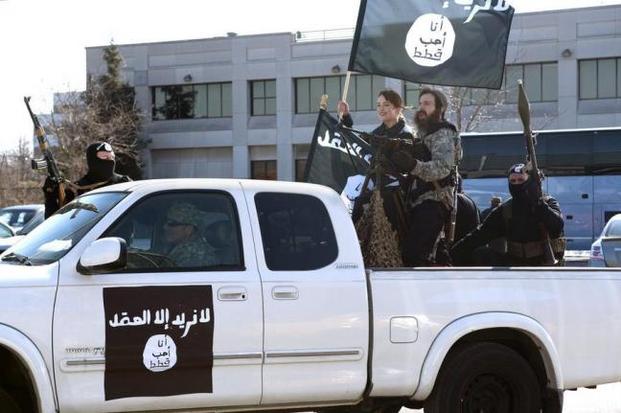ISIS may be on the move, but not the way you see on television, claims the Pentagon.
Footage of the menacing, black-clad terrorist army rolling across the desert in long convoys predates U.S.-led air strikes that have forced the jihadists to travel more discreetly, say senior State Department and Pentagon officials. They have asked television networks to stop using stock footage that makes the terror army seem more mobile - and more formidable - than they say it actually is.
“One Toyota speeding down the road by itself at night with its headlights off,” would be a more accurate image, said Pentagon spokesman Col. Steven Warren.
“One Toyota speeding down the road by itself at night with its headlights off [would more accurate].
Emily Horne, spokeswoman for retired Gen. John Allen, the State Department’s special envoy leading the international coalition against ISIS, said the footage being used by news networks paints a picture that benefits the terror group, also known as ISIL and Islamic State.
“We are urging broadcasters to avoid using the familiar B-roll that we’ve all seen before, file footage of ISIL convoys operating in broad daylight, moving in large formations with guns out, looking to wreak havoc,” Horne told Politico. “It’s inaccurate — that’s no longer how ISIL moves.
“A lot of that footage is from last summer before we began tactical strikes.”
U.S. news media have not been permitted to send embedded reporters into areas of Iraq and Syria where fighting is fiercest, making it nearly impossible to get up-to-date footage of ISIS' movements. But even if the terrorist army's mobility is restricted by strikes from above, there is scant evidence that the combination of Iraqi boots on the ground and coalition bombers in the sky is turning the tide against the radical jihadists.
Iraqi forces backed by U.S. airstrikes took back the city of Tikrit from ISIS in March, and U.S. officials estimate that ISIS has lost as much as a quarter of its territory and as many as 6,000 fighters. Yet on Friday, ISIS militants captured the main government compound in Ramadi, the capital of Iraq's western Anbar province, forcing Iraqi troops to retreat from the compound and watch from afar as the black flag of ISIS was raised.
The terrorists also remain in control of the key Iraqi city of Mosul and much of northern Iraq and Syria. The potential capture of Ramadi, a critical city in central Iraq just 70 miles west of Baghdad, would represent a stunning defeat for coalition forces.
Rick Brennan, a senior political scientist at the RAND Corporation who spent five years as a senior adviser to the U.S. military in Iraq, said the Pentagon has a point, if all it is talking about is ISIS travel methods.
"Before the summer offensive of 2014, ISIS was moving in large columns which were extremely easy targets to hit," Brennan told FoxNews.com. "But as a result of the successful airstrikes, they have broken down and are moving as an insurgency under the cover of darkness."
Brennan said the terrorist army has now embedded itself in cities and among civilian populations, allowing ISIS to hold onto power with little risk from airstrikes.
"We have complicated their ability to move," Brennan said. "On the level of being able to move rapidly and reinforce rapidly, they are no longer able to do that. But their ability to hold terrain has not diminished."
According to Central Command, strikes have hit nearly 6,300 targets in Iraq and Syria since the campaign dubbed Operation Inherent Resolve began last Aug. 8. Some 1,500 tanks, Humvees, technical and miscellaneous vehicles were hit from the air between Aug. 8 and March 31, while just 76 were struck between March 31 and May 8, according to the Pentagon.
Coalition nations conducting airstrikes in Iraq include the U.S. Australia, Belgium, Canada, Denmark, France, Jordan, the Netherlands and the United Kingdom. Coalition nations conducting airstrikes in Syria include the U.S., Bahrain, Canada, Jordan, Saudi Arabia and the United Arab Emirates. The U.S. still handles the vast majority of the strikes in both Iraq, where American planes drop two-thirds of the bombs, and Syria, where the U.S. share is 94 percent.






























